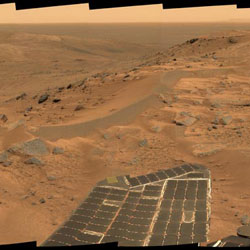
Spirit’s view of Mars. Image credit: NASA/JPL. Click to enlarge.
Remote-sensing orbiters, probes, landers and rovers are returning astonishing discoveries about our solar system. But some of the most exciting geological and potentially astrobiological places in our family of planets and moons are dangerous and difficult to explore.
University of Arizona, California Institute of Technology, and U.S. Geological Survey Flagstaff researchers propose a novel space mission concept for finding and exploring the most scientifically important surfaces and subsurfaces throughout the solar system.
These next-generation robotic missions will simultaneously explore distant locales at several levels – from orbit, from the air and on the ground – to home in on important geology, hydrology, climate and possibly astrobiology in distant worlds, said James M. Dohm of The University of Arizona. Dohm, a planetary geologist in UA’s department of hydrology and water resources, has mapped Mars at local to global scales. He is involved with autonomous long-range roving, sensor web and orbiting spacecraft experiments.
Wolfgang Fink, a visiting associate at Caltech, Dohm and others discuss the new mission concept in an article, “Next-generation robotic planetary reconnaissance missions: A paradigm shift,” to be published in Elsevier?s journal of Planetary and Space Science (http://www.elsevier.com/, go to Article in Press link). They spearheaded a team effort that includes Mark Tarbell, who is Fink’s associate in Caltech’s Visual and Autonomous Exploration Systems Research Lab; Trent Hare of the U.S. Geological Survey office in Flagstaff; and Victor Baker, Regents’ Professor of the UA departments of hydrology and water resources, planetary sciences and geosciences.
The new mission concept would feature orbiting spacecraft, blimps and balloons at planets or moons with sufficient atmospheres, such as Titan, and numerous simple, deployable mobile and immobile ground sensors. These spaceborne, airborne, and ground agents would be programmed to look smartly at the environment and interact with each other, offering a true “tier-scalable” perspective needed for a science-driven mission, Dohm said.
“We are now at an optimal window in time when spacecraft and airborne units can coordinate with ground-based sensors, especially since much of the technology is already available,” said Fink, a physicist and an expert in imaging systems, autonomous control and space mission science analysis systems. “Even technology not currently available — software, primarily — is quite attainable.”
?It’s important to look at layers and layers of evidence, not just one type,” Dohm said.
For example, Fink said, a rover with feature-recognition software can look for a unique rock that could contain a critical piece of the history of Mars. “If you add an airborne perspective, you also see what?s on the other side of the hill at the same time, and you know the rover’s exact field location as well,” he said. The orbiter has the global picture of what’s going on and commands the airborne and ground tiers below it.
The orbiter in a tier-scalable mission is equipped with current information about the surface, atmosphere and other features of its destination. Its sensor suite might include optical and thermal cameras, spectrometers, and ground-penetrating radar. These instruments would collect information on areas that the orbiter’s software recognizes as possible interesting targets given the overall mission science goals.
“The orbiter can deploy the airborne agents for a closer look,” Fink said. “The orbiter also can command the airborne agents to safely deploy ground agents to the prime targets. The airborne agents help detect and confirm prime targets.”
“The ground agents can measure information such as heat or moisture,” Dohm said. “Or they can sample or collect diverse rocks and, in the case of Mars, possible near-surface water. There could be numerous lightweight, expendable sensors, so that even if you lost a few, you’d still have mission.”
The sensors send information back to their respective airborne probes, and ultimately to the orbiting spacecraft. Based on this new information, the orbiter sends new commands that drive the mission.
“The spaceborne, airborne, and ground agents all work together as a field geologist,” Dohm said. “They analyze information to form a working hypothesis.” They would be ideal for exploring Valles Marineris, the expansive canyon system of Mars, or Europa’s putative ice-covered ocean, he added.
In the case of Valles Marineris, for instance, Dohm said, the orbiting spacecraft would deploy sensors that would transmit weather conditions back to the spacecraft. If the sensors give the spacecraft a good weather report – no high winds, for example – the spacecraft would then release the balloons or blimps. These airborne agents would start their searches for targets important to mission goals, collecting and adding new information as they go and deploying ground agents at promising candidate sites. The ground agents would collect and return data to the higher-level airborne probes, or the orbiter, or both. “If the goal at Valles Marineris was to find possible water seeps or near-surface water, a drill rig might even be deployed at the most promising site,” Dohm said.
Fink and Dohm say the new concept needs further design, testing and ground-truthing in diverse Earth environments. They envision field camps for international researchers for designing and testing possible tier-scalable reconnaissance systems.
Intelligent, science-driven robotic space missions are a decade or two in the future, they will be international, and they will have significant corporate and private sponsorship, Dohm and Fink predict.
Original Source: University of Arizona News Release
